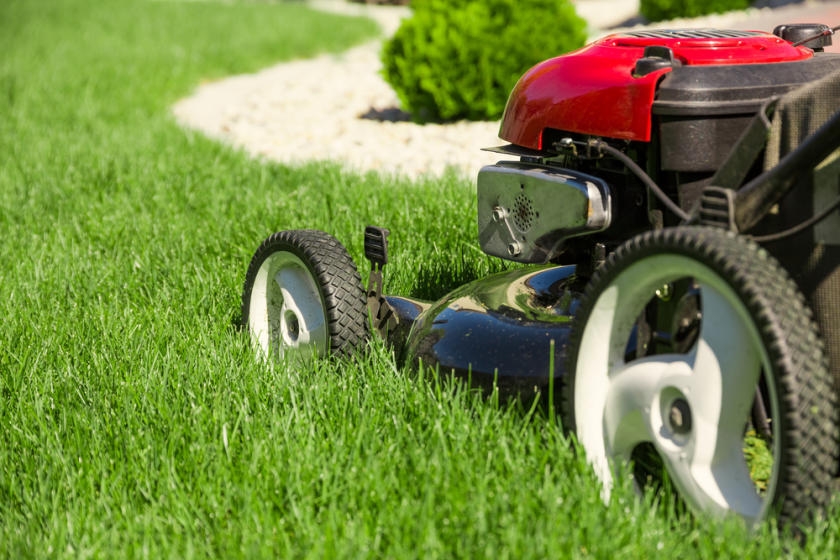Mowing your yard correctly is the first step to a great-looking lawn. Even if you feel you’re handy with a mower, it doesn’t hurt to brush up on your skills. Here are some basic lawn care tips on how to mow and manicure a lush lawn that looks spectacular.
Mower Maintenance
Keeping your mower maintained and in excellent working condition is probably the most important mowing tip that can keep you mowing right. The quality of your mowing job depends on a machine that runs efficiently and effectively. Routinely show your mower some love to keep it working well for you.
-
Step 1: Keep It Clean
You don’t have to clean your mower after every use, but periodically cleaning it will help it run better. If you only clean it once a year, do it before storing it for the winter; you don’t want to store a dirty mower and give debris and grime a chance to settle in and bog it down. Thoroughly clean the engine and frame of the mower. Use a scraper to remove any built-up dirt and grass clippings from the underside of the mower and rinse the underside with a garden hose. Check the air filter and replace it if it is dirty.
-
Step 2: Check the Blade
Check the condition of the blade once the mower is clean. If the blade needs sharpening, use a heavy file to sharpen dull edges. If the blade looks a little worse-for-wear, you can simply replace it. Check the blades once per year.
-
Step 3: Change the Oil
Change the oil each season to keep your mower moving in prime condition. Like your car, the mower’s engine requires fresh oil to run at peak power and capability. There are many makes and models of mower and they may require specific oil change procedures. Carefully consult your mower’s manual.
Generally, you can begin to change mower oil by starting the mower and letting it run until the engine is warm. After stopping the engine, disconnect the ignition cable from the spark plug to avoid the possibility of a spark. Turn the mower over on its side so that the oil drain (usually on the side of the engine) is facing down. Place an oil pan on the ground underneath the drain and then unscrew the plug and let the old oil drain into the pan. You will most likely need a wrench or socket wrench to loosen the plug.
Helpful Tip
If the location of your mower’s oil drain makes it infeasible to let it drain directly in the pan, use a funnel to catch the oil from the drain and guide it into the pan.
When all the oil has drained, replace the plug and make sure it is snug by tightening it with a wrench. Next, locate the oil filter and place a pan underneath it. Unscrew the oil filter with an oil filter wrench to get it started and then by turning it with your hand. Let the used oil drain into the pan and empty the filter into the pan as well. Wipe up any spills with a rag. Rub a bit of used oil on the rubber gasket of a new filter and then screw the new filter into place with your hands, finishing it with a turn of the oil filter wrench.
Remove the oil reservoir cap/dipstick and then pour in the type and amount of engine oil recommended by the manufacturer. After filling the reservoir with oil, let it sit for a few minutes. Then, check the oil level with the dipstick, wiping the dipstick clean with a rag, after each check. Add more oil if necessary. Hopefully, you won’t have too much oil now, but if you do, you will need to drain the reservoir again. Too much oil can be as bad as too little.
-
Step 4: Store it Properly for Winter
Before you give your lawn mower the season off, remove its fuel by running the mower until it runs out of gas and the motor stops. Don’t just dump out the fuel. Change the oil and remove the spark plugs. Change the spark plugs if necessary and then reinstall the spark plug without connecting the ignition cable.
Mow Right
Some homeowners are great with the mechanical upkeep of their mowers but lack skill in how they use them. The following lawn care tips will provide you with some mowing guidelines to keep your grass in tip-top shape.
-
Step 1: Don’t “Scalp” It
One mistake mowers often make is cutting the grass too short. Always set your mower’s blade to the correct height for your type of grass. If you’re not sure, set the blade so that you don’t cut off more than 1/3 of the grass blades’ height. Grass that is too short makes your lawn susceptible to crabgrass and damage from the sun. Grass height should be at least 2″. But if you have let your grass grow out, don’t immediately cut it down to the recommended 2″ height. Set your mower’s cutting height so that it will only cut off 1/3 the height of the grass blades. The next time you mow, you can lower it and cut it at 2″. This is easier on your grass and lessens the chances of damaging or killing it.
-
Step 2: Cut it Regularly
Cut your grass regularly. Once a week is ideal. During hot and/or dry spells, your lawn may not grow as quickly. When this occurs, it’s best to wait until the next mowing day so that you don’t damage the lawn.
-
Step 3: Mind Your Technique
You want to push your mower in parallel rows. Using a sidewalk, driveway or other non-grass surface as a guide and a starting point, begin mowing parallel to the surface and work your way across the lawn, turning at each end and mowing alongside the row you just made.
Helpful Tip
To ensure you don’t miss any grass, keep your mower’s wheel just inside the previously cut row.
You can use a grass bag or catcher with your mower, to leave it looking clean and neat. Remember not to let the bag become too full. When this happens, grass begins to clump and these clumps fall out from underneath the mower and leave your lawn looking messy. Empty the grass catcher when you notice that it’s almost full.
Helpful Tip
Clumps and grass clippings can be spread across the yard with a general-purpose rake so that your lawn isn’t messy looking. It is also good for the grass, as the clippings act like mulch.
Safety Alert!s
Before mowing, pick up debris that could be thrown from under the mower and cause damage or injury, such as rocks, sticks, trash, etc.
Carefully read your mower’s manual so that you know how to properly use the machine and avoid injury.
That’s it! By keeping these lawn care tips in mind and combining them with some proper maintenance and mowing technique, your lawn will be the envy of the block.
Project Shopping List
Here’s what you’ll need to complete this project successfully.












